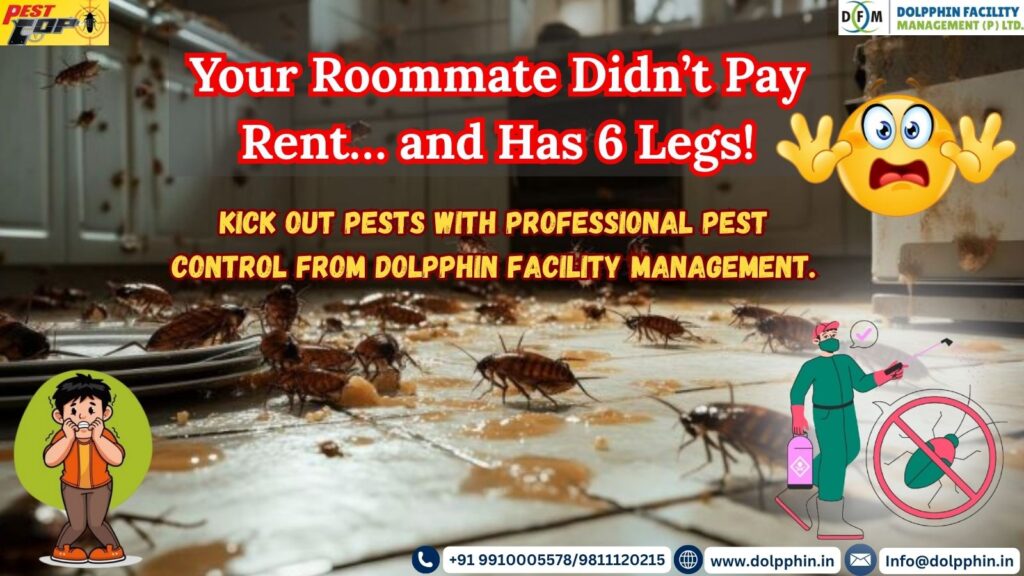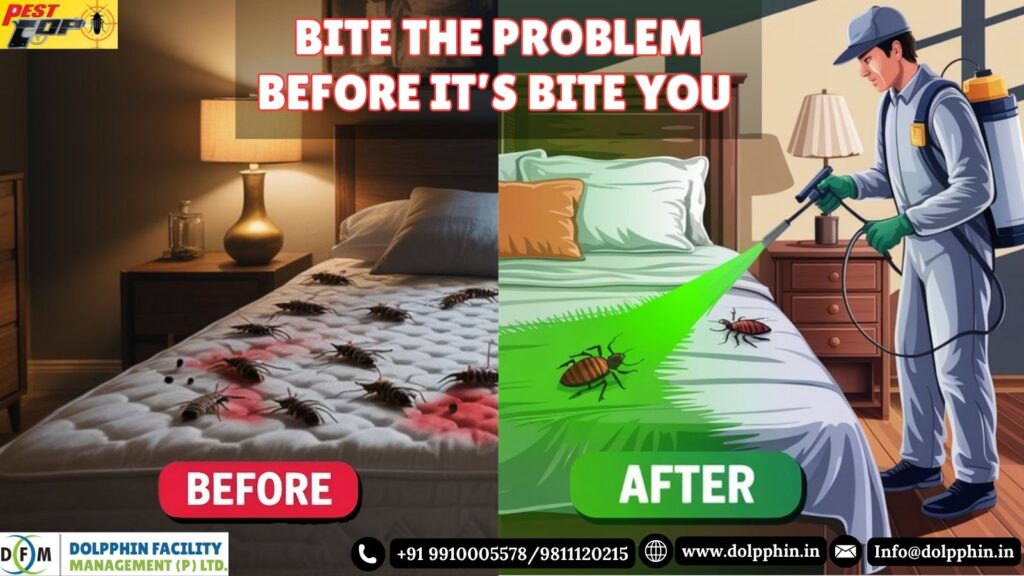
INTRODUCTION
You just noticed that one cockroach in your kitchen? You are not alone, we assure you. Beyond being creepy crawlies, cockroaches are experts at surviving. They can quickly proliferate and conceal themselves in even the smallest crevices, transforming your otherwise tranquil house into a nightmare plagued by pests. Once inside, they create what Dolpphin Facility Management Pvt. Ltd. refers to as the “Hidden Roach Economy”—a covert invasion that grows like a financial scam.
The "Roach Economy": What is it?
The self-sustaining, rapidly expanding infestation that begins with a single cockroach is known as the “roach economy.” A single roach can grow into a colony of more than 300 in as little as six months under the right circumstances. They procreate quickly, conceal themselves well, and take advantage of your food, warmth, and shelter without your consent. Unbeknownst to you, they are quietly but persistently compromising your hygiene behind your refrigerator, inside cabinets, and beneath the sink. Their numbers increase exponentially and silently, much like compound interest in finance.
How Quickly Do Cockroaches Multiply?
The cockroach breeding cycle is incredible. About 30 to 40 eggs are laid at a time by a female cockroach, and they hatch in 28 to 30 days. Within three to four weeks, these juvenile roaches mature into breeding adults, resuming the cycle. One cockroach can quickly grow into 30, and those 30 can grow into 900, if nothing is done. In as little as six months, hundreds of cockroaches may turn your house into a secret breeding ground without your knowledge.
The Actual Risks Associated with Cockroach Infestation
In addition to being unwelcome visitors, cockroaches pose a major risk to human health. Salmonella, E. coli, and dysentery are among the dangerous bacteria and viruses that they can spread. Additionally, their presence exacerbates allergies and asthma, especially in older adults and children. Additionally, their droppings, saliva, and shed skins contaminate food. Many homeowners experience psychological discomfort as a result of the stress of witnessing cockroaches crawl out during the night, particularly in the kitchen or bathroom.
Warning Signs of an Unwanted Roach Army
Certain indicators can point to an expanding cockroach infestation, even if you haven’t noticed many. Keep an eye out for brown egg cases concealed in shadowy areas, a musty smell that lingers, especially in cabinets and drawers, and droppings that look like ground pepper. Significant red flags include smear marks on walls or appliances and cockroach sightings at night. Keep in mind that there are probably dozens more lurking in the shadows if you have spotted even one.
Cockroaches Are Smarter Than You Think: Why DIY Projects Fail
Although you might believe that your store-bought spray is sufficient, do-it-yourself solutions rarely produce long-lasting effects. Only the visible cockroaches are killed by the majority of over-the-counter products; the hidden ones are left unaffected. These pests hide in difficult-to-reach places, like wall crevices, drainage lines, and electrical appliances. Cockroaches become immune to common chemicals over time, and missed eggs can re-infest an area within a few days. DIY solutions might lower apparent numbers, but they won’t solve the underlying issue.
A Professional Approach to Cockroach Control at Dolpphin Facilities Management
At Dolpphin Facility Management Pvt. Ltd., we tackle the issue head-on rather than merely patching it up. A thorough examination of your property to find breeding areas is part of our expert cockroach control service. We employ chemical or herbal gel baits, which are very safe for kids and animals and very effective. Our technicians guarantee focused application in storage spaces, drains, restrooms, and kitchens. To guarantee complete eradication, we also provide follow-up treatments and seal cracks and crevices. Our method is long-lasting, environmentally friendly, and effective.
Before one becomes 300, make your reservation now!
You deserve a healthy, roach-free, and clean home. Avoid allowing a single roach to grow into a hundred-strong infestation. Before it’s too late, take action now.
Give us a call at 9910005578 or 9811120215. Visit our website at www.dolpphin.in. Send an email to info@dolpphin.in.
We have already earned the trust of thousands of satisfied customers in Delhi NCR for their pest control requirements. You ought to!
FAQs on Cockroach Control
Q: Is your treatment safe for kids and pets?
✅ Yes, we use odorless, herbal, or gel-based solutions that are non-toxic and safe for your family.
Q: How long does a single treatment take?
🕒 Typically, a treatment session lasts 30–45 minutes, depending on the size of the property and level of infestation.
Q: Will one visit be enough?
🔁 In mild cases, yes. But heavier infestations may require 2–3 follow-up visits to eliminate eggs and hidden colonies completely.
CONCLUSION
Avoid waiting for the infestation to become unmanageable. The lone cockroach you observed today might be the beginning of a nasty trend. There might be a full-fledged cockroach economy operating covertly at your expense beneath your appliances and behind the walls.
Stop it with the assistance of professionals.
Select Dolpphin Facility Management Pvt. Ltd., your go-to source for cutting-edge cockroach suppression.
👉 DENY FOOD | DENY SHELTER | DESTROY AND CONTROL
Making the wise choice to hire us now is the first step toward having a clean and secure home.

 Who Are These Dangers Who Drop Mice?
Who Are These Dangers Who Drop Mice? Indications That Your Home Is a Live Bed Bug Podcast
Indications That Your Home Is a Live Bed Bug Podcast Why DIY Doesn't Make the Mic Silent
Why DIY Doesn't Make the Mic Silent Go Pro: Use Skilled Bed Bug Control to Close Their Podcast
Go Pro: Use Skilled Bed Bug Control to Close Their Podcast Avoid Becoming Famous (for the wrong reasons) Due to Bed Bugs
Avoid Becoming Famous (for the wrong reasons) Due to Bed Bugs Conclusion:Put an End to the Rumors and Get Back to Sleep
Conclusion:Put an End to the Rumors and Get Back to Sleep
 Why Cockroaches Are More Than Just Gross
Why Cockroaches Are More Than Just Gross Signs That You Have Unwanted Roommates
Signs That You Have Unwanted Roommates DIY Methods Vs. Expert Pest Control
DIY Methods Vs. Expert Pest Control Our Method:
Our Method: Why Choose Us?
Why Choose Us?








